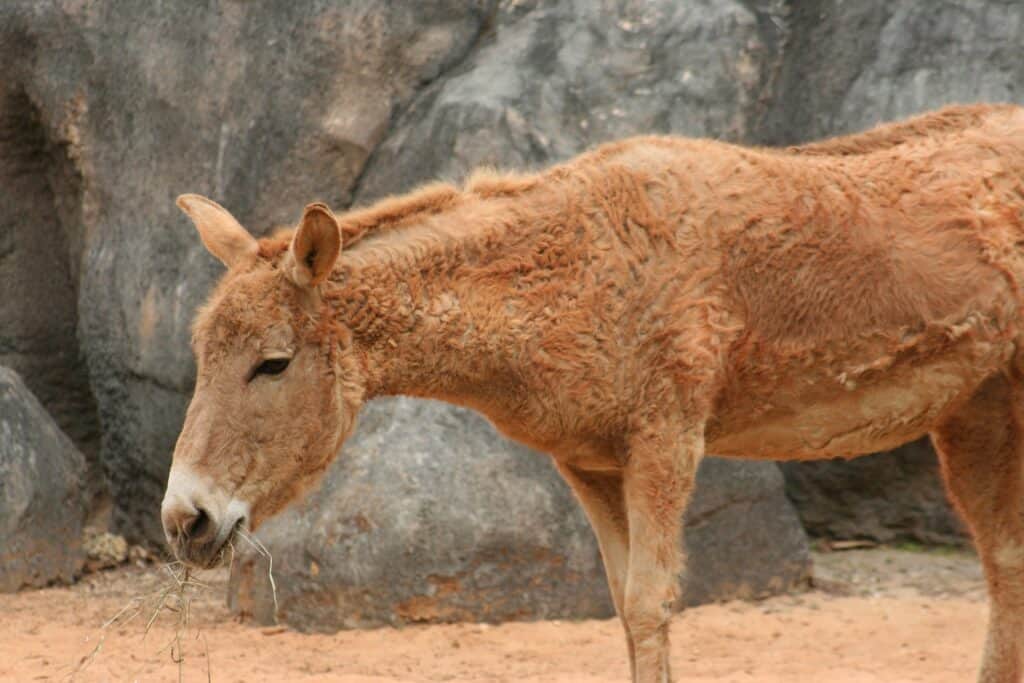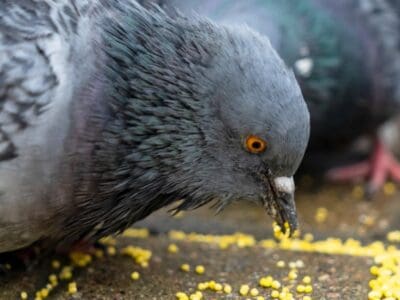Onager
Equus hemionus
An onager's coat changes color with the season.
Advertisement
Onager Scientific Classification
- Kingdom
- Animalia
- Phylum
- Chordata
- Class
- Mammalia
- Order
- Perissodactyla
- Family
- Equidae
- Genus
- Equus
- Scientific Name
- Equus hemionus
Read our Complete Guide to Classification of Animals.
Onager Conservation Status
Onager Facts
- Name Of Young
- foal, colt
- Group Behavior
- Herd
- Herds
- Fun Fact
- An onager's coat changes color with the season.
- Estimated Population Size
- 28,000
- Biggest Threat
- poaching, fragmentation, habitat loss
- Most Distinctive Feature
- black dorsal stripe with white borders
- Gestation Period
- 11 months
- Temperament
- unruly
- Age Of Independence
- one to two years
- Litter Size
- one foal
- Habitat
- desert, grasslands, arid grassland, shrublands, desert plains, oases, steppes, mountain steppes, and the savanna
- Predators
- gray wolf
- Diet
- Herbivore
- Lifestyle
- Crepuscular
- Favorite Food
- perennial grasses
- Origin
- asia
- Migratory
- 1
Onager Physical Characteristics
- Color
- Brown
- Grey
- Yellow
- Red
- White
- Multi-colored
- Skin Type
- Hair
- Top Speed
- 70 mph
- Lifespan
- 14 to 26 years
- Weight
- 440 to 640 pounds
- Height
- 4.9 feet
- Length
- 6.9 to 8.2 feet
- Age of Sexual Maturity
- 2 years
- Venomous
- No
- Aggression
- Low
View all of the Onager images!
An onager’s coat changes color with the season.
Facts
- Endangered: Onagers are an endangered species of equines. Only 28,ooo exist in the world today.
- Almost extinct: Only 600-700 Persian onagers are left in the wild today.
- Good memory: Onagers are very intelligent animals. They have a great memory and can recall the face of someone they met 25 years prior, so make sure you’re nice to them.
- Free-spirited souls: The task of domesticating onagers was “abandoned” many years ago when humans found it easier to tame horses and donkeys.
- Winter coat: Onagers are adaptable to weather changes. In times of extreme cold, they can grow a curly, dense coat for the winter.
Onager Summary
If you are a keen reader of historic texts and literature, you might have come across the mention of the onager. Previously used as beasts of burden, onagers were once domesticated, but now, they live in the wild. They bear a remarkable resemblance to donkeys, and it would take a trained eye to tell them apart. Two subspecies of the onager are extinct and the species is near threatened.
Onager Scientific Name
Onager is a name that comes from the Greek words onos meaning “donkey” and agrios meaning “wild.” Scientifically, the onager is known as Equus hemionus. The generic name Equus is Latin for “horse” while the specific name is a compound word derived from Greek hemi and onos meaning “half donkey.” Onagers are also called hemiones or the Asiatic wild ass.
Members of the genus Equus are odd-toed ungulates, which refers to animals with hoofs, and they have oval-shaped hoofs. Other animals that belong to this genus are horses and zebras.
The onager consists of five subspecies with the Mongolian wild ass as the nominate subspecies.
- Mongolian wild ass (E. h. hemionus) – the nominate subspecies
- Syrian wild ass (E. h. hemippus)
- Persian onager (E. h. onager)
- Indian wild ass (E. h. khur)
- Turkmenian kulan (E. h. kulan)
- European wild ass (E. h. hydruntinus)
The European wild ass and the Syrian wild ass are both extinct subspecies. The name Onager is commonly used only for the Persian onager whose subspecific name is onager, but it is actually the name of the entire species.
Onager Evolution and History
Onagers belong to the genus Equus which houses every living equine. The oldest known equine fossil found in Idaho comes from Equus simplicidens and is described as resembling a zebra but with the head structure of a donkey. Onagers have existed for over four million years, being among the oldest Equus species to diverge from their most recent common ancestor followed by the African zebra.
Many ancient literary works mention onagers. They were domesticated thousands of years ago and originally used as beasts of burden. However, human beings never managed to completely tame these wild creatures and so they were replaced by the horse, donkey, and mule.
Onager Appearance

Onagers are adaptable to weather changes. In times of extreme cold, they can grow a curly, dense coat for the winter.
©Hawkeagle20/Shutterstock.com
Onagers are a species of wild asses. They have a short mane, large ears, and pale hair that changes color depending on the season. In the summer, they become reddish-brown, and this changes to yellowish or grayish-brown in the winter. The onager’s winter coat gets longer and coarser as well.
Commonly misidentified with donkeys, onagers are much larger than donkeys. They weigh up to 440 to 640 pounds and are 6.9 to 8.2 feet in length and 4.9 feet at the shoulder. Also, onagers look more horse-like than donkeys. Another distinguishing feature between donkeys and onagers is a black stripe with a white border that runs down the middle of the onager’s back. Onagers have white rumps, bellies, and muzzles.
Onager Behavior
Onagers are crepuscular animals with activity levels peaking during dusk and early in the morning at dawn when the weather is cooler and lowering when the sun is out.
Although onagers can get their required daily amount of water from their food alone, they prefer to live near a reliable water source. This comes in handy, especially for lactating mothers who need a consistent supply of water. Onagers are a migrating species and make large migratory hikes that cover up to 15 square miles annually.
Onagers are also very social animals that practice polygamy. They live in groups of about 10 to 12 members. The group usually includes a male onager (jack), a group of females (jennets), and their offspring. Onagers tend to form much bigger groups during fall and winter when and where resources are abundant and this herd can swell to sizes of 300 to 1,200 individuals. This herd is not uniform and is made up of several autonomous groups that break off after a short while in the herd. Older jacks are usually solitary.
When threatened by a predator, onagers defend themselves as most equids do and work together to kick powerfully at their assailant and chase them away.
When it comes to their relationship with people, this species is infamously difficult to tame. They are quite a stubborn species.
Onager Diet
Onagers are herbivorous and folivorous animals. Their diet consists primarily of perennial grasses, and they also forage for herbs, fruit, leaves, and, in more arid climes, trees and shrubs. They are also known to feed on tree bark.
Onagers tend to live very close to water bodies. When water is lacking, they dig holes into dry riverbeds to reach water near the surface. In the colder months, onagers have been seen eating snow as a source of water. They get their required liquid intake from the food they consume.
Onager Habitat and Population
Onagers live in arid, temperate, and cold regions of Asian countries including China, Iran, Uzbekistan, Turkmenistan, India, Mongolia, and Israel. These equids inhabit grasslands, shrublands, desert plains, oases, steppes, mountain steppes, and the savanna.
The onager subspecies prefer to reside in different habitats. You can find this Mongolian wild ass in the deserts and grasslands of Mongolia and northern China. They are the most widespread onager subspecies, but their population is dwindling due to poaching and habitat loss. They are extinct now in Kazakhstan and some regions in China and Siberia.
As its name suggests, the Indian wild ass inhabited the arid regions and desert steppes of northwest India and Pakistan. However, now, 4,500 individuals are located in Gujarat, living in wildlife sanctuaries.
The Turkmenian kulan prefers to live in cold and hot deserts. You can find this subspecies in Turkmenistan and returning to Uzbekistan and Kazakhstan through reintroduction.
The rare Persian onager likes to reside in desert and semidesert regions of Turkmenistan and northeastern Iran. This subspecies was decimated by the loss of habitat, resource competition with domestic livestock, and poaching. About 600 to 700 government-protected Persian onagers are left in the wild and less than 100 in captivity worldwide.
According to the IUCN Red List of Threatened Species, the Persian onager is an endangered species with only about 790 individuals in total remaining. The onager species is Near Threatened on the protection list with only about 28,000 onagers worldwide. The onager species is currently extinct in Jordan, Syria, some parts of Siberia, Saudi Arabia, Iraq, and Palestine.
Onager Reproduction and Lifespan
Onagers reach sexual maturity at two years old but they don’t typically start mating until they reach three to four years of age. These animals practice polygyny, where one male mates with multiple females in one season. They do this in two main ways. Firstly, dominant onager males typically guard territories that are abundant in resources such as food and water. Then, the females wander between these guarded areas to mate with them. In the other mating method, a dominant male mates with the females in his harem and breeds with them.
Mating season takes place from April through to September, peaking in the summer months of June and July. Gestation usually lasts 11 months and the female onager gives birth for a bit over ten minutes to usually one foal. Onager foals are precocious and can stand up with little to no help and nurse just 15 to 20 minutes after given birth to. These foals reach full independent age at one to two years of age.
Onagers can live a plentiful life of 14 years in the wild and up to 26 years in captivity.
Onager Predators and Threats
Equids such as onagers usually have a long list of natural predators that hunt them. The onagers in Iran are prey to Persian leopards and striped hyenas. In India, mugger crocodiles are on the hunt for migratory onagers. Asiatic lions, tigers, Asiatic cheetahs, and bears also prey on them. Presently, gray wolves are the primary predator of onagers.
Apart from predation, onagers also face the following threats:
- Poaching for their meat, hide, and body parts
- Competition with domestic livestock for resources
- Acute separation from other members of their subspecies which can lead to adverse genetic conditions from continuous inbreeding
- Fragmentation as a result of human encroachment into the onager’s natural habitat.
The onager is a protected species in most of the countries it inhabits and many breeding programs have been set up to ensure that the onager has a future. It is currently being reintroduced to some of its native territories.
Onager Related Animals
View all 66 animals that start with OOnager FAQs (Frequently Asked Questions)
What is the difference between a donkey and an onager?
Onagers may look like donkeys at first glance, but you can quickly tell them apart if you know what to look for.
Onagers are much larger than donkeys. Also, onagers look more horse-like than donkeys. Another distinguishing feature between donkeys and onagers is a black stripe bordered by white that runs down the middle of the onager’s back. Onagers have white rumps, bellies, and muzzles.
How long do onagers live?
Onagers have a lifespan of 14 years in the wild. However, that number increases to 26 when they are in captivity.
Are onagers extinct?
Two subspecies of onagers are extinct: the Syrian and the European wild asses. However, the other living subspecies are near threatened except for the Persian onager which is endangered.
How tall are onagers?
Onagers measure up to 4.9 feet at the shoulder.
How heavy are onagers?
Onagers are pretty heavy animals. They can weigh anything from 440 to 640 pounds!
How do onagers protect themselves?
Onagers are usually calm animals by nature, but that doesn’t mean you should underestimate them. True to their equine heritage, these animals pack a powerful kick. They defend themselves from predators and assailants by ganging up on their target, kicking them, and chasing them away from the herd.
Can I keep an onager as a pet?
Our ancestors tried that…it didn’t exactly work out. Onagers were historically used as beasts of burden, but their unruly behavior made it impossible to fully tame them so we just left them alone and chose horses and donkeys instead.
What do onagers eat?
Onagers are herbivores and folivores, which means they eat leaves. Their diet consists primarily of perennial grasses, and they also forage for herbs, fruit, leaves, and, in more arid climes, trees and shrubs. They are also known to feed on tree bark.
What is a baby onager called?
Baby onagers are called foals or colts. Female onagers are called jennys or jennets, and male onagers are called jacks or jackasses.
Thank you for reading! Have some feedback for us? Contact the AZ Animals editorial team.
Sources
- Animal Diversity, Available here: https://animaldiversity.org/accounts/Equus_hemionus_onager/
- Wikipedia, Available here: https://en.wikipedia.org/wiki/Onager
- Wikipedia, Available here: https://en.wikipedia.org/wiki/Mongolian_wild_ass
- Animalia, Available here: https://animalia.bio/onager
- Young People's Trust for the Environment, Available here: https://ypte.org.uk/factsheets/ass/the-mongolian-wild-ass


















